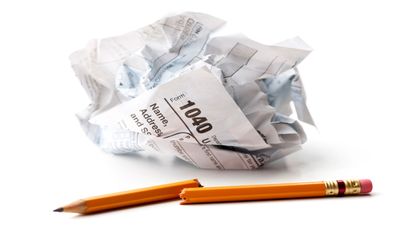The IRS has already delivered millions of third-round payments. Here are some reasons why your third stimulus check might not arrive at all, if you’re still waiting for your money.
If your response is “no,” you may have to wait a little longer to receive your payment. Have you received your third stimulus check yet? Millions of Americans have already received their third-round stimulus check, which the IRS began distributing in mid-March. You may have to wait a while if all of your friends and family have already received their money and you are still without any. Furthermore, a third stimulus check might never come for some people.
You can track the progress of your third stimulus check using the IRS’s “Get My Payment” tool, but it won’t arrive any faster (or ever). The best course of action is to try to determine why your payment is delayed or won’t arrive, and then take appropriate action. See the next eight reasons why your third stimulus check might be rejected or delayed. However, if you qualify for a third stimulus check, just know that you will receive your money eventually.
The Economic Impact Payments (EIPs), commonly known as stimulus checks, were a series of direct payments issued by the Internal Revenue Service (IRS) to eligible individuals and families as part of the U.S. government’s response to the COVID-19 pandemic. While the IRS has completed the distribution of all EIPs, understanding the program and eligibility requirements is crucial for individuals who may be seeking to claim a Recovery Rebate Credit on their tax return.
Eligibility for Economic Impact Payments
To be eligible for an EIP, individuals must have met specific income and residency requirements. Generally, eligible individuals included U.S. citizens, permanent residents, and resident aliens with valid Social Security numbers who were not claimed as dependents on another person’s tax return. The income thresholds varied depending on the specific EIP payment.
Payment Amounts and Distribution
The amount of each EIP varied based on income and filing status. The first EIP, issued in 2020, provided up to $1,200 for individuals and $2,400 for married couples filing jointly. The second EIP, also issued in 2020, provided up to $600 for individuals and $1,200 for married couples filing jointly. The third EIP, issued in 2021, provided up to $1,400 for individuals and $2,800 for married couples filing jointly.
The IRS distributed the EIPs through direct deposit, paper checks, and debit cards. The majority of eligible individuals received their payments automatically based on information from their 2019 tax return or Social Security Administration data.
Claiming the Recovery Rebate Credit
Individuals who did not receive the full amount of the EIPs or did not receive any payments at all may be eligible to claim the Recovery Rebate Credit on their tax return. The specific EIP for which the credit can be claimed depends on the individual’s eligibility and the tax year they are filing for.
To claim the Recovery Rebate Credit, individuals need to file a 2020 or 2021 tax return, even if they are not typically required to file. The IRS provides specific instructions and forms for claiming the credit.
Reasons for Delayed Stimulus Payments
There were several reasons why some individuals may have experienced delays in receiving their stimulus payments. These reasons include:
- Incomplete or inaccurate tax information: The IRS relied on tax return information to determine eligibility and payment amounts. Individuals who did not file a tax return or provided inaccurate information may have faced delays.
- Changes in eligibility status: Individuals whose income or filing status changed between the time the EIPs were issued and the time they filed their tax return may have needed to claim the Recovery Rebate Credit to receive the full amount they were entitled to.
- Processing backlogs: The IRS faced significant processing backlogs due to the high volume of EIPs and other pandemic-related tax relief measures. This resulted in delays for some individuals.
- Verification of eligibility: In some cases, the IRS may have needed to verify an individual’s eligibility before issuing a payment. This could have led to delays for individuals who were not initially identified as eligible.
Checking Payment Status and Additional Information
Individuals can check the status of their EIPs and Recovery Rebate Credit through the IRS’s “Get My Payment” tool or by accessing their online IRS account. The IRS also provides extensive information about the EIPs and Recovery Rebate Credit on its website.
While the IRS has completed the distribution of EIPs, understanding the program and eligibility requirements remains crucial for individuals who may be seeking to claim the Recovery Rebate Credit on their tax return. By reviewing the information provided by the IRS and consulting with a tax professional if necessary, individuals can ensure they receive the full amount of the EIPs they are entitled to.
You Didn’t File a 2019 or 2020 Tax Return
If you qualify for a third stimulus check, the IRS will typically review your 2019 or 2020 tax return to ascertain the amount of your check. The IRS is stuck if you failed to file a 2019 or 2020 return (not everyone is required to file one). It lacks the readily available information necessary to send you a payment.
In certain cases, the IRS obtained the required data from another federal agency that provides benefits to you (e g. from the Department of Veterans Affairs, Railroad Retirement Board, or Social Security Administration The IRS was able to begin paying those beneficiaries as soon as it received the information, but there was a delay while it awaited the data. For instance, millions of federal beneficiaries are receiving payments from the IRS that were only recently initiated. (Note also that the way these federal beneficiaries receive their regular benefits will typically be the same for their third stimulus payment.) ).
You will have to claim the amount you are entitled to as a Recovery Rebate credit on your 2021 tax return if the IRS is unable to obtain the information necessary to process your payment (or a full payment). However, there is a simple workaround for this: even if you are not required to, just file a 2020 tax return.
Theres still plenty of time to file a 2020 return. The IRS extended the deadline for filing returns for this year from April 15 to May 17, 2021, giving you one more month to submit your 2020 tax return to the IRS. In the event that you have not yet filed, you can still receive a check; it will just take longer for you to receive it. The tax agency has until the end of the year to distribute third-round stimulus payments.

The IRS will send your third stimulus check or debit card to the address it has on file if, for any reason, you are scheduled to receive a paper check or debit card in the mail (instead of a direct deposit payment). You will have to wait longer to receive your money if you recently moved and the IRS sends your payment to the incorrect address. The mere fact that your payment is being sent by mail is reason enough for a delay.
If the U. S. You should eventually receive your third-round stimulus payment in your mailbox as the Postal Service is forwarding your mail to your new address. However, it will inevitably take longer and cause further delays.
However, you will have the option to have your money directly deposited into a: if the Postal Service is unable to deliver your payment and returns it to the IRS.
- Bank account;
- Prepaid and reloadable debit card; or
- An alternative financial instrument that is linked to an account and routing number
You will authorize the direct deposit using the IRS “Get My Payment” tool. The entire process of having your payment returned to the IRS and then setting up a direct deposit payment will take some time, even though direct deposit is quicker than having a reissued payment sent by mail.
If you dont sign up for direct deposit after your initial payment is returned to the IRS, it will take even longer to receive your third stimulus check. In that case, the IRS wont reissue your payment until it receives an updated address (e.g., by filing a 2020 tax return or notifying the IRS).
You will not receive a third payment and will need to claim the amount of your third stimulus check as a Recovery Rebate credit on your 2021 tax return if, after your first payment is returned by the Postal Service, you do not enroll in direct deposit or notify the IRS of your new address.

You Have a New Bank Account
If the IRS has your bank details from:, your third stimulus check payment will be deposited straight into your bank account.
- Your 2019 or 2020 federal income tax return (Form 1040);
- the tool “Non-Filers: Enter Payment Info Here” for stimulus payments in the first round;
- if the data was given in 2020, the “Get My Payment” tool;
- A federal agency that issued benefits to you (e. g. the Railroad Retirement Board, the Department of Veteran Affairs, or the Social Security Administration); or
- Federal records of recent payments to or from the government.
The quickest and most straightforward way to deliver your payment is via direct deposit. The payment will be postponed, though, if the IRS has your bank account closed recently. Legally, if the account is closed or inactive, the bank is required to return the payment to the IRS. Regretfully, there is no way to give the IRS the details of your new bank account in order to apply for a third stimulus check if you closed your account. Consequently, you will either receive a debit card or paper check in the mail.
Receiving a direct deposit payment is quicker than receiving a paper check or debit card from the IRS because the former must be sent via regular mail.
You will have to claim the money from the third stimulus check that you should have received as a Recovery Rebate credit on your 2021 income tax return, which you won’t file until the following year, if the IRS doesn’t send any payments for the third round.

IRS Tax Refund Update – Delays and Smaller Refunds
FAQ
Why is my stimulus taking so long to deposit?
What if I still haven’t received my $1400 stimulus?
How come I haven’t received my stimulus check?
What if you’re still waiting for your stimulus check?
Are stimulus checks delayed?
Stimulus checks may be delayed for some customers, the IRS and major tax prep software companies warned this week. The problem is direct deposited payments bouncing from temporary or alternative bank accounts used to receive the first round of stimulus payments which the companies have now closed.
What if my stimulus check doesn’t arrive by direct deposit?
For more on the checks, here’s when the IRS will start sending the third checks, how much you could qualify for with this payment and how to track your payment with the IRS. If your stimulus check doesn’t arrive by direct deposit by the end of today, the IRS says you’ll get a paper check or EIP card — even if there’s been a direct deposit error.
Will you get a stimulus check from a bank account?
It’s most likely that people who have filed their 2020 or 2019 tax returns and have a bank account on file with the tax agency will quickly receive their stimulus checks through direct deposit, based on the prior payment rollouts.
When will a stimulus check be delivered?
With the previous two rounds of stimulus checks as precedent, the IRS is likely to deliver most payments to eligible Americans by mid-April. People whose latest tax return includes direct-deposit information will get theirs first. A stimulus check is a non-taxable cash payment sent to qualifying Americans by direct deposit, check, or debit card.
